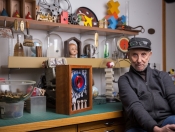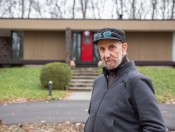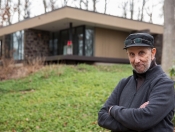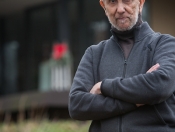RAJIE COOK
Narrative written by Ann de Forest
Photos by Dave Tavani
Fluent in the expressive possibilities of visual communications, Rajie Cook knows how to convey meaning through signs and symbols, to send messages in a language that transcends barriers of cultural and linguistic differences. In a 50-year career as a graphic designer, Rajie (known professionally as Roger) developed corporate communication projects for clients like IBM, Black & Decker, and AT&T. With his partner Don Shanosky, he developed iconic pictograms for the U.S. Department of Transportation, which to this day guide people to restrooms and restaurants, to currency exchange and public transportation all over the world.
In his retirement, Rajie, now 87, turned from graphic design to art that communicates with the same force and economy. In his sculptural assemblages, he repurposes ordinary objects to create indelible images that expose and protest human rights abuses in the Middle East, especially in Palestine, his parents’ homeland. Objects such as rocks, keys, dolls’ heads, plastic hands, or a metal faucet serve as three-dimensional pictograms conveying poignant, political messages. A cast-iron bird with a Palestinian flag entwined in barbed wire, represents a dove of peace, unable to fly free. Plastic eggs bound in criss-crossed string evoke the children of Palestine, denied education, unable to hatch. The keys, a recurring motif in Rajie’s art, refer to the homes lost by more than 800,000 Palestinians by 1949. The women he met in refugee camps in his travels to Palestine still wear the keys to their former homes around their necks, totems of hope for eventual return.
When Rajie’s father, Najeeb Esa Cook, a Christian Palestinian born in Ramallah, left his home at the turn of the 20th century, he too envisioned return. Najeeb carried with him an English surname, Cook, which had been bestowed on his father by a British officer who, impatient with the lyrical polysyllables of the family name, had anglicized his Turkish nickname Küçük (the equivalent of “Shorty”). Najeeb traveled to America, in search of work, moving from city to city across the United States, picking up jobs as a peddler, a miner, and a restaurateur, moving as far west as Missouri before he headed back home 13 years later. He returned to Palestine just long enough to marry, and eventually brought his bride back to America in 1927, to start a family in the land of opportunity.
Rajie, the second of his parents’ five children, was born in 1930, three years after his parents immigrated to the United States. In New Jersey, where the family settled, Rajie’s 4th grade teacher scrubbed the residue of Arabic from his first name too. Rajie became Roger, a solid American name he would use throughout his professional career.
Rajie/Roger grew up in Depression-era New Jersey straddling two worlds. He can recall in vivid detail the tastes and smells of his mother’s home cooked Middle Eastern dishes. The street in Newark where they lived bubbled with a variety of aromas, tastes, and sounds.
“I can still hear the accordions and guitars,” says Rajie. He describes his neighborhood as “veritably, a smorgasbord of the map of Eastern and Western Europe and the Middle East.”
The children bonded through American pastimes of baseball and gospel while their parents formed friendships with one another, across cultural and ethnic differences. They shared a common purpose, Rajie says, “the desire for a better life for themselves and their children.”
But Najeeb, a salesman of fine linens imported from Italy and Portugal, was gradually losing his eyesight and went blind when Rajie was in middle school. Najeeb let go of the dream of returning to Ramallah, but never, in his long, robust life, gave up his hopes for peace in the land of his birth.
Rajie Cook was 51 years old when he visited Palestine for the first time. His father had died the year before, and Rajie made the trip, in part, to honor his father’s memory by going back to the place his parents had left in 1927, three years before Rajie was born. Rajie had grown up hearing his father’s vivid tales from his childhood — memories of walking several miles to Jerusalem in the shadow of the Dome of the Rock to sell eggs that his mother had exchanged with the Bedouins for vegetables. Memories of guiding tourists through the Garden of Gethsemane, where he made the stories and characters from the Bible come to life.
The Middle East that Rajie visited in 1981 clashed with his father’s turn of the century recollections. Rajie was not prepared for the human tragedy he encountered. The abject conditions, the daily humiliations, the oppression and violence displaced Palestinians endured, whether living in refugee camps in Jordan or waiting for hours at checkpoints just to get to work in Jerusalem touched him deeply. That homecoming was his awakening, transforming Rajie into an activist and advocate for human rights in Palestine.
In 1989, he returned to Palestine again, as a layperson in a humanitarian task force led by the U.S. Presbyterian Church. They went to Gaza where conditions were worse than in the refugee camps in Jordan. “We met with 25 different people – Christians, Muslims, Bedouins,” Rajie remembers. “It was obvious to us that something was terribly wrong…. When I called home, I broke down. I couldn’t handle it.” His impassioned voice conveys at once empathy and fury as he describes the flimsy temporary housing in a refugee camp, the corrugated metal roofs weighted down with rocks to keep them in place when the high winds blow, or the maze of checkpoints and humiliating challenges Palestinians must go through just to do mundane errands. “As I was leaving Gaza, boarding on the bus, I asked, ‘What can I do?’” He wanted to convey the horrors he had seen. He wanted the world to recognize the humanitarian crisis taking place in the Occupied Territories.
“After my first visit to Gaza,” he says, “I found my mission was to create public awareness about its tragedy, that Palestinian society is living under one of the longest military occupations in modern history.” The best way he knew to do that was to communicate through his art.
As Rajie makes a plea for peace and justice with his art, he is also honoring his parents, especially his father. Blindness prevented Rajie’s father from ever appreciating the ads, posters, logos, and signs that made his son a success, or from seeing the powerful art works Rajie creates to draw attention to Palestinians’ plight. For his part, Rajie is surprised that many Americans seem unwilling to hear his message. He even has encountered people who tell him that his parents’ homeland does not exist, that it never existed. “When people tell me there was no Palestine,” he says. “They’re telling me my parents weren’t real. They were a dream.”
To show that his father’s life – and the country he came from – are very real, Rajie has labored over the past 10 years to write a book dedicated to his father. A Vision for My Father connects Rajie’s own life, work, and political awakening to his family’s roots and his father’s immigrant story. “The Palestinian artist has to fight to get his or her voice heard,” Rajie writes. When the book is published this fall, more people may hear Rajie’s voice.
Rajie has never himself felt displaced, though he clarifies “I have always been proud of who I am and where my roots are.” He appreciates how full, happy, and productive his life has been. He and his wife Peggy made a home for themselves and their family in the Bucks County countryside. Rajie helped design the two modernist pavilions composed of glass, wood and local stone, which seem to float through the bare trees in the winter woods. Inside their home, expansive windows draw in the surrounding trees and light; outdoors and indoors fuse. The other pavilion is Rajie’s studio, where he sorts and stores his flea market finds — salvaged wood, discarded objects, broken tools, cracked saws and splintered hammers – and transforms them into potent, pointed messages promoting human rights. In his studio, he observes, castaway objects, themselves displaced, find a home and a purpose, telling the stories of people who have lost their place in the world.
Rajie is aware that he owes the life he has enjoyed, the opportunities and successes that have been given him, to his parents. As he grows older, he understands even more how heart wrenching it must have been for his father to uproot himself. His ancestors can trace their family tree in Palestine back more than 500 years. Rajie knows his life could have easily taken a different course. He has seen firsthand how bleak and brutal life is for so many Palestinians today, and imagines what kind of person he would have become if his parents never had gone to America. “I might have been throwing rocks at tanks at an early age, and I might have been shot — or been in prison, and then shot.”
He is sure he would have resisted the oppression and fought against injustice. But without art to sustain his spirit, he imagines his passion for his people would have been fueled by bitterness. “My creativity would have been stifled, my spirit crushed …If my father hadn’t come here, my life might have been quite different. It certainly would have been shorter.”
Imagining this other life so clearly, Rajie says he want his art to speak for those who never had his opportunities. He speaks up and speaks out, and like his father, at the end of his life, he waits and hopes and advocates for peace in the Middle East. Rajie’s name, the Arabic name he reclaimed in his later years, means “hopeful.” Above all else, hope is the message he wants the world to hear and embrace.






 Emi and Afaq Mahmoud
Emi and Afaq Mahmoud  Cocoa Mahoney
Cocoa Mahoney  Yasser Allaham
Yasser Allaham  Gulnora Ravshan
Gulnora Ravshan  “Floating Outsider”
“Floating Outsider”  “Ahmad” & “Zainab”
“Ahmad” & “Zainab”  Jack and Gloris Dunnous
Jack and Gloris Dunnous  Maria Turcios
Maria Turcios  Lafayette El
Lafayette El  Tara O’Brien
Tara O’Brien  Sophia Simpson
Sophia Simpson